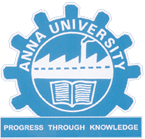 ANNA UNIVERSITY CHENNAI:: CHENNAI 600 025
ANNA UNIVERSITY CHENNAI:: CHENNAI 600 025
CURRICULUM 2004
B.TECH. INFORMATION TECHNOLOGY
SEMESTER III
IT1202 PRINCIPLES OF COMMUNICATION 3 1 0 100
IT1202 PRINCIPLES OF COMMUNICATION 3 1 0 100
AIM
To have knowledge about Analog and Digital transmission of both Analog data and Digital Data, Security, modulation and different accessing methods.
OBJECTIVES
• To have understanding about different types of AM Communication systems (Transmitters & Receivers)
• To study in detail the different types of FM transmitters & Receivers and PM Transmitters and Receivers
• To gain knowledge about different digital modulation techniques for digital transmission.
• To have knowledge about base band transmission ISI and distortion free base band transmission
• To know the spread spectrum modulation techniques and different multiple access methods.
UNIT I AMPLITUDE MODULATION: TRANSMISSION AND RECEPTION 9
Principles of amplitude modulation – AM envelope, frequency spectrum and bandwidth, modulation index and percent modulation, AM power distribution, AM modulator circuits – low level AM modulator, medium power AM modulator, AM transmitters – low level transmitters, high level transmitters, Receiver parameters.
AM reception: AM receivers – TRF, Superheterodyne receivers, Double Conversion AM receivers.
UNIT II ANGLE MODULATION: TRANSMISSION AND RECEPTION 9
Angle Modulation – FM and PM waveforms, phase deviation and modulation index, frequency deviation, phase and frequency modulators and demodulators, frequency spectrum of a angle modulated waves, Bandwidth requirement, Broadcast band FM, Average power FM and PM modulators – Direct FM and PM, Direct FM transmitters, Indirect transmitters, Angle modulation Vs. amplitude modulation.
FM receivers: FM demodulators, PLL FM demodulators, FM noise suppression, Frequency Vs. phase Modulation.
UNIT III DIGITAL MODULATION TECHNIQUES 9
Introduction, Binary PSK, DPSK, Differentially encoded PSK, QPSK, M-ary PSK, QASK, Binary FSK, MSK, Duobinary encoding – Performance comparison of various systems of Digital Modulation.
UNIT IV BASEBAND DATA TRANSMISSION 9
Sampling theorem, Quadrature sampling of bandpass signals, reconstruction of message from its samples, Signal distortion in sampling, Discrete PAM signals, power spectra of Discrete PAM signals, ISI Nyquist Criterion for Distortionless baseband binary transmission, eye pattern, baseband M-ary PAM systems, adaptive equalization for data transmission.
UNIT V SPREAD SPECTRUM AND MULTIPLE ACCESS TECHNIQUES 9
Introduction, Pseudo-noise sequence, DS spread spectrum with coherent binary PSK, Processing gain, FH spread spectrum, multiple access techniques, wireless communications, TDMA and CDMA, wireless communication systems, source coding of speech for wireless communications.
TUTORIAL 15
TOTAL : 60
TEXT BOOKS
1. Wayne Tomasi, “Electronic Communication Systems: Fundamentals Through Advanced”, Pearson Education, 2001.
(UNIT I Chapters- 3,4; UNIT II : Chapters-6,7; UNIT III Chapters-12).
2. Simon Haykin, Digital Communications, John Wiley & Sons, 2003. (UNIT IV Chapters-3,4; UNIT V Chapters-7,8)
REFERENCESS
1 Simon Haykin, Communication Systems, John Wiley & Sons, 4th edn.,2001.
2. Taub & Schilling, Principles of Communication Systems, TMH, 2nd edn., 2003.
3. Martin S.Roden, Analog and Digital Communication System, PHI, 3rd edn. 2002.
4. Blake, Electronic Communication Systems, Thomson Delman, 2nd edn., 2002.


0 comments :
Post a Comment